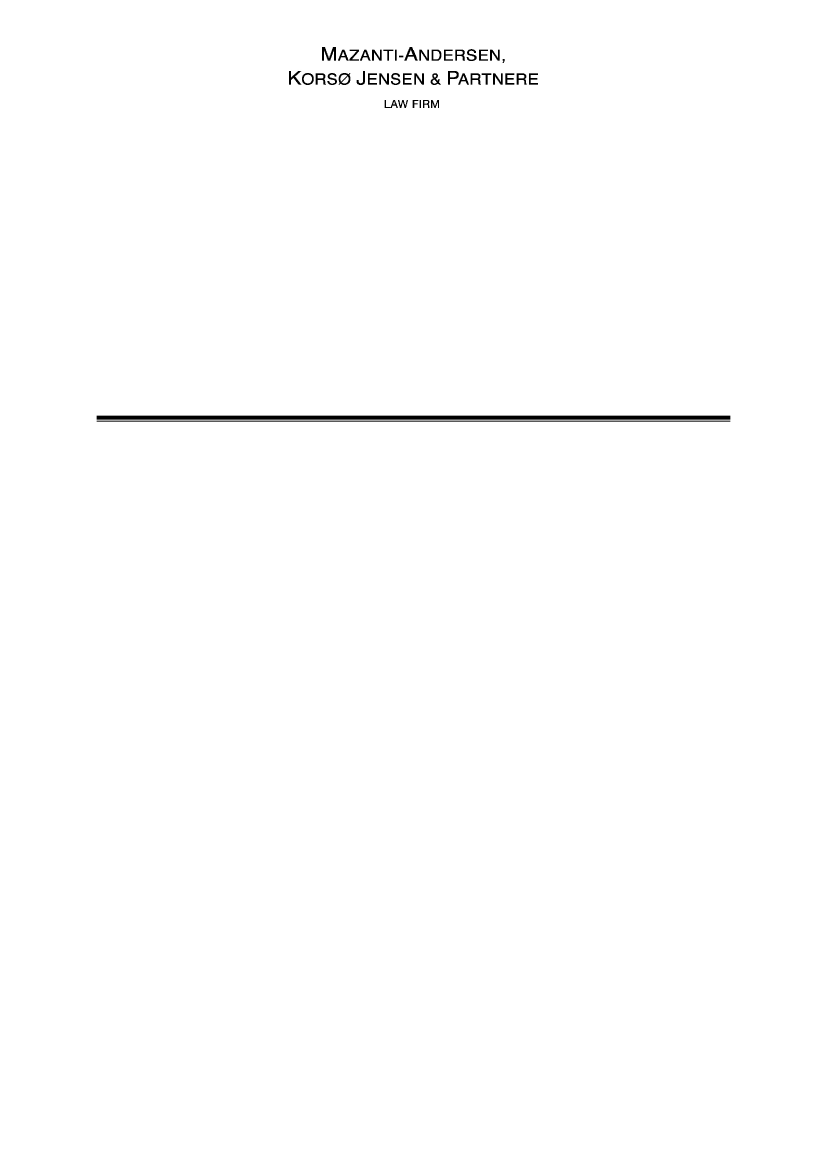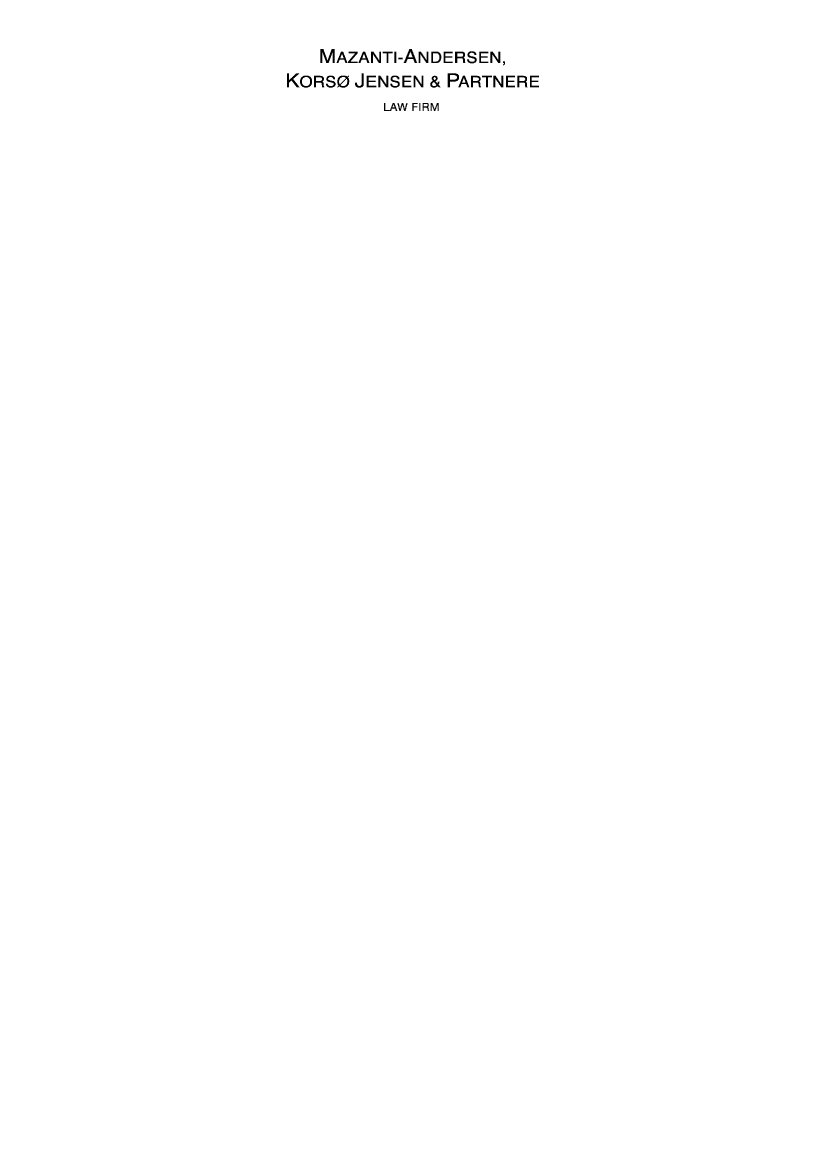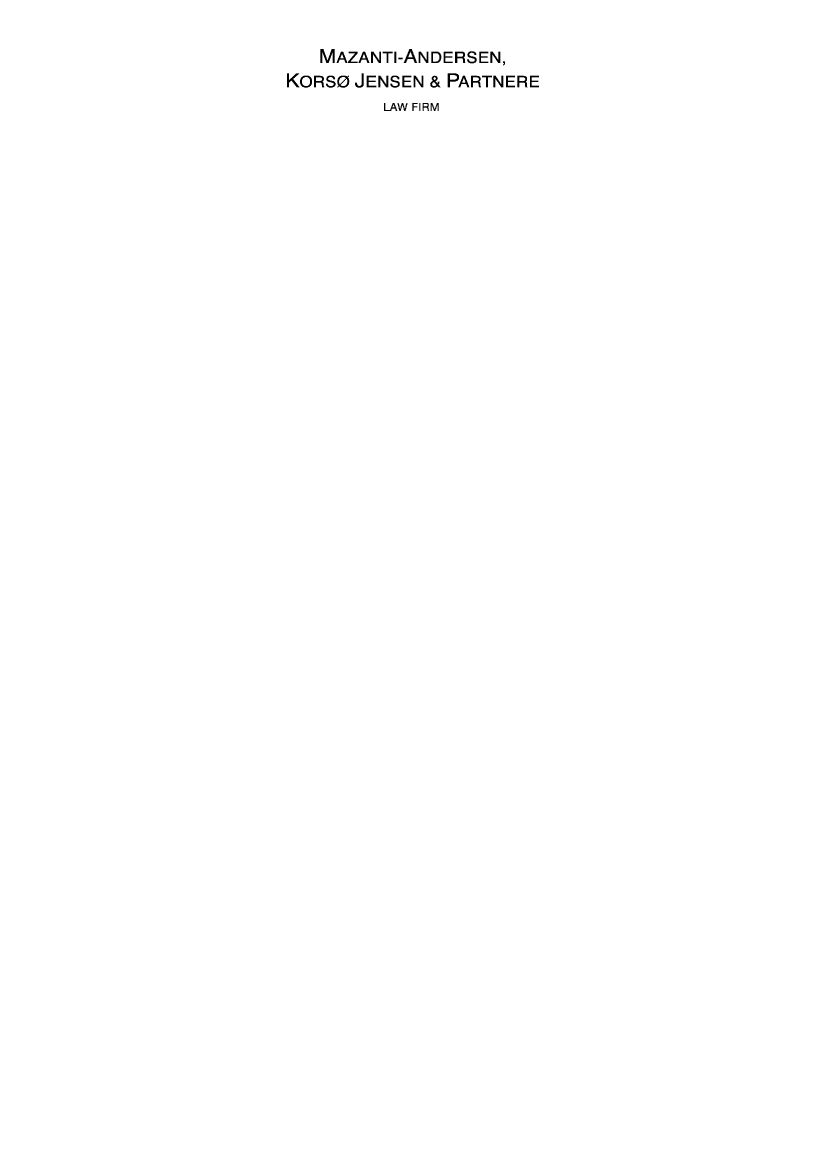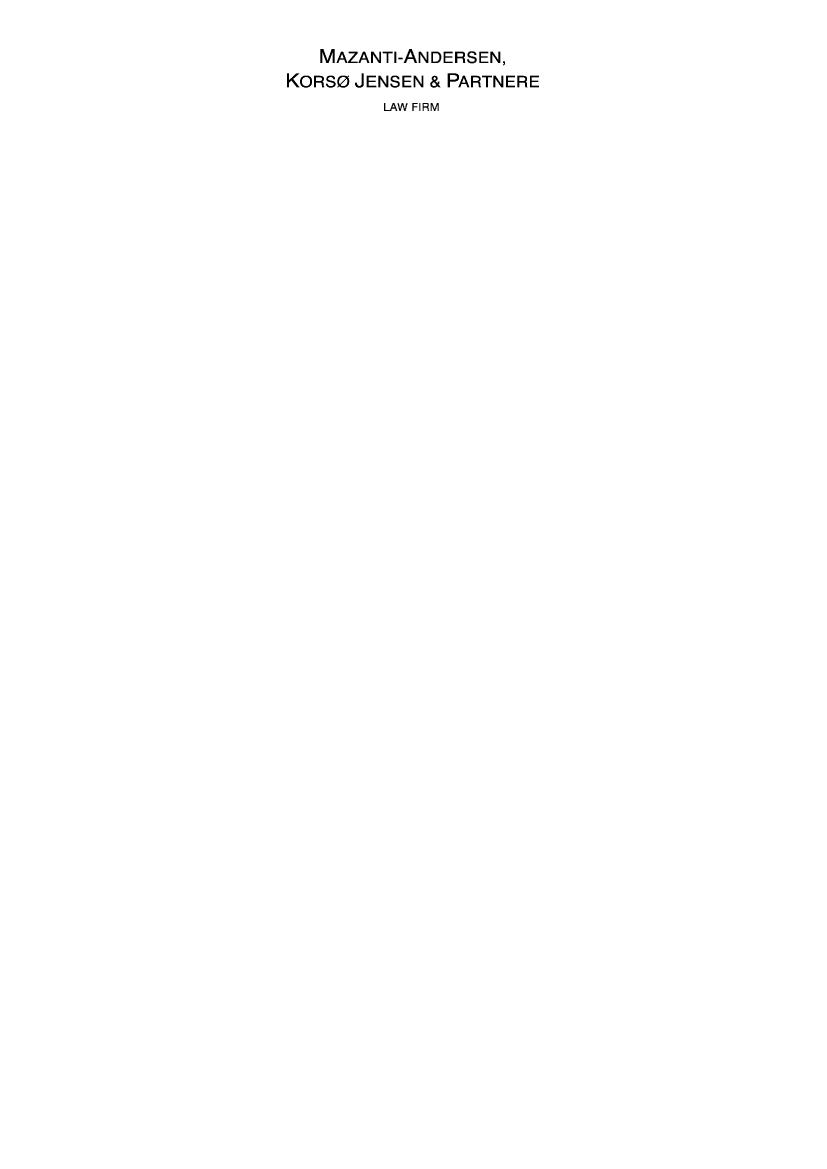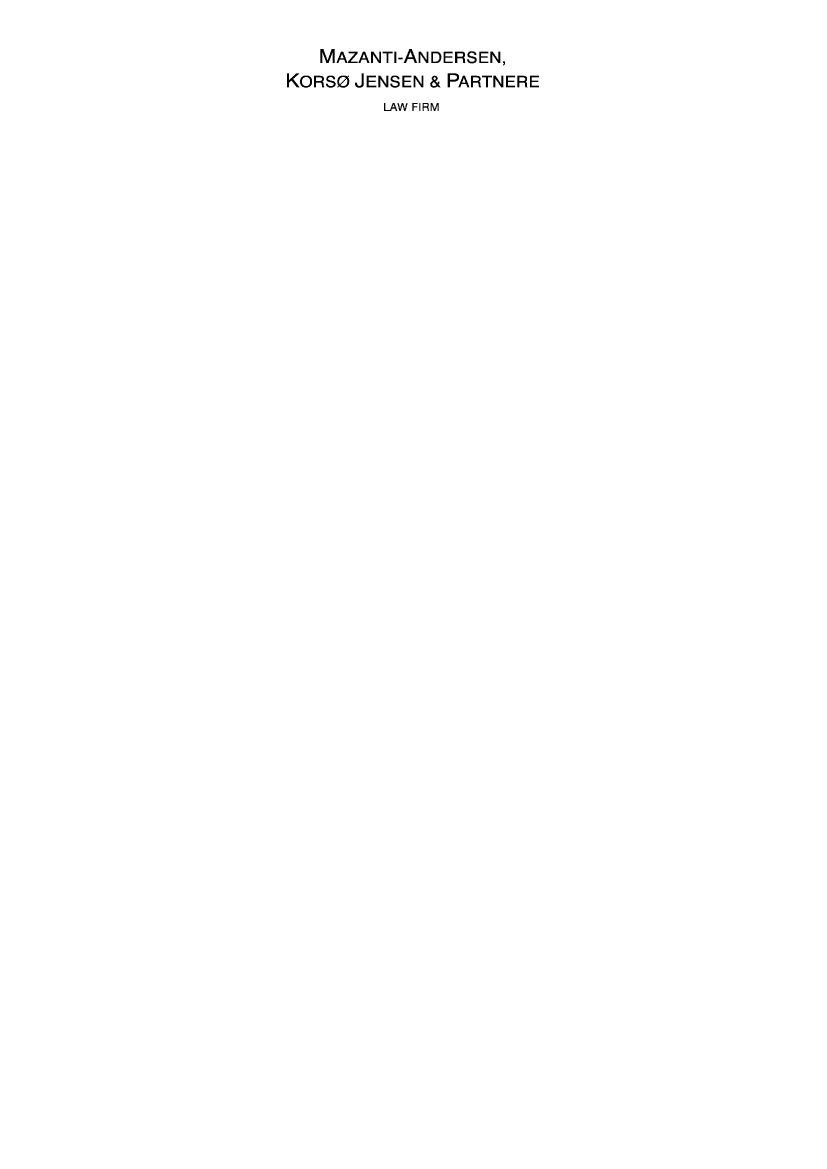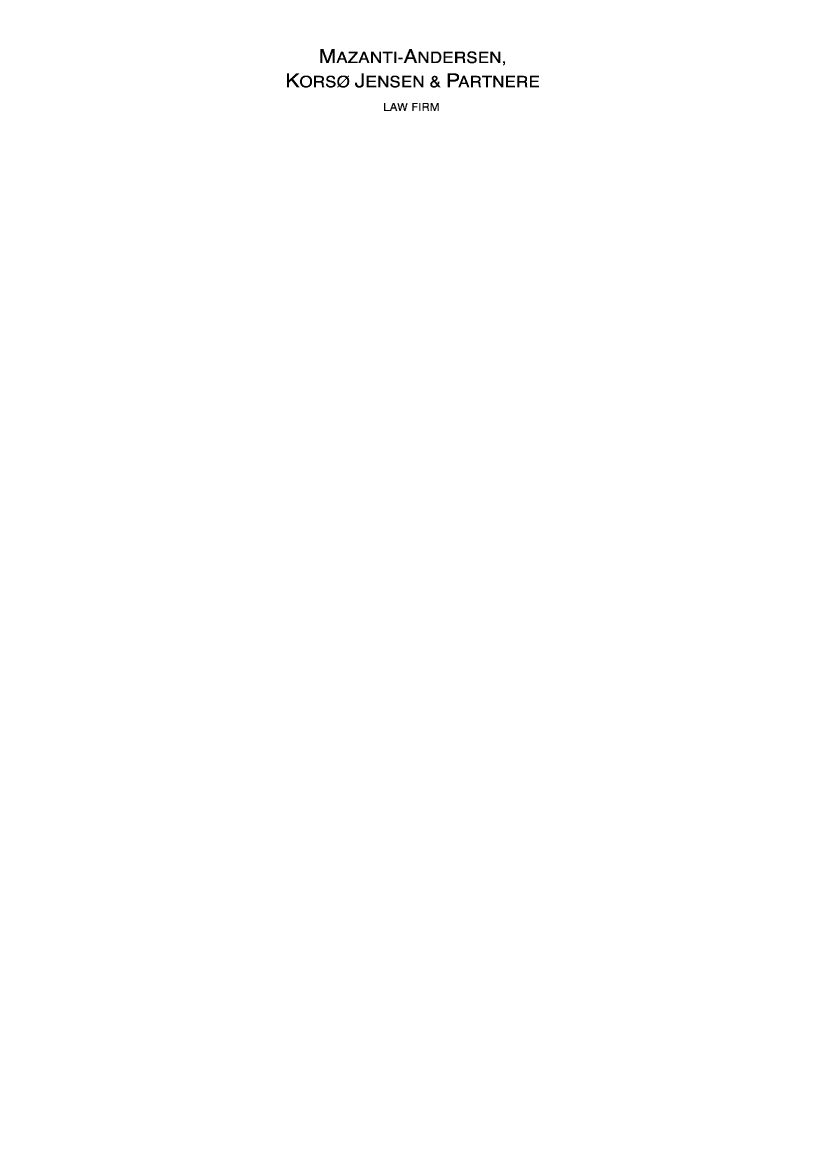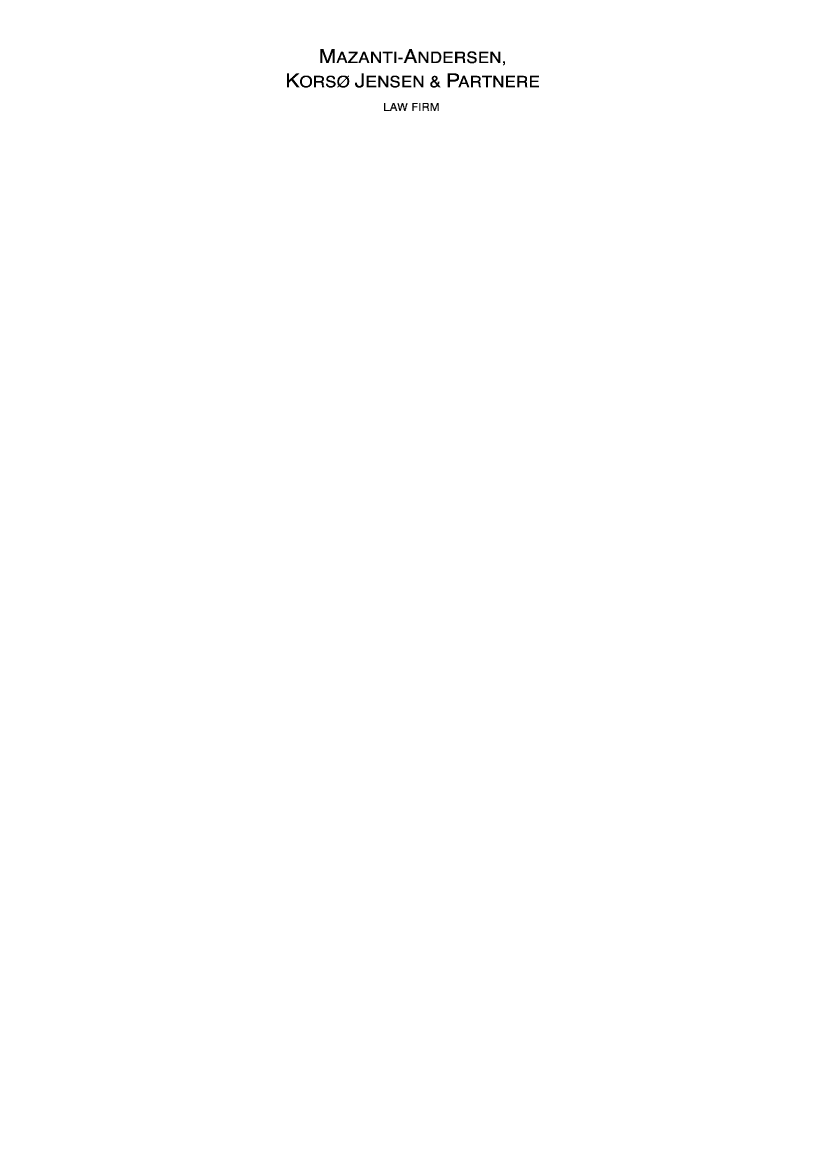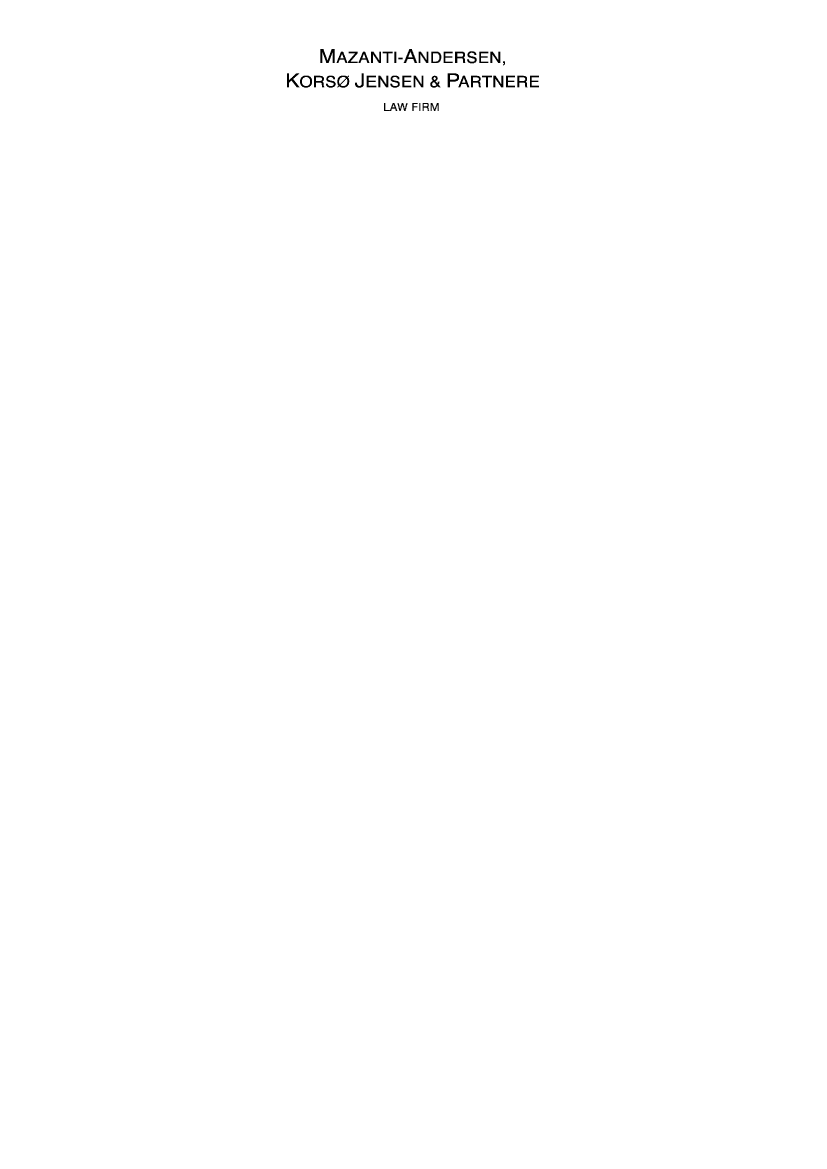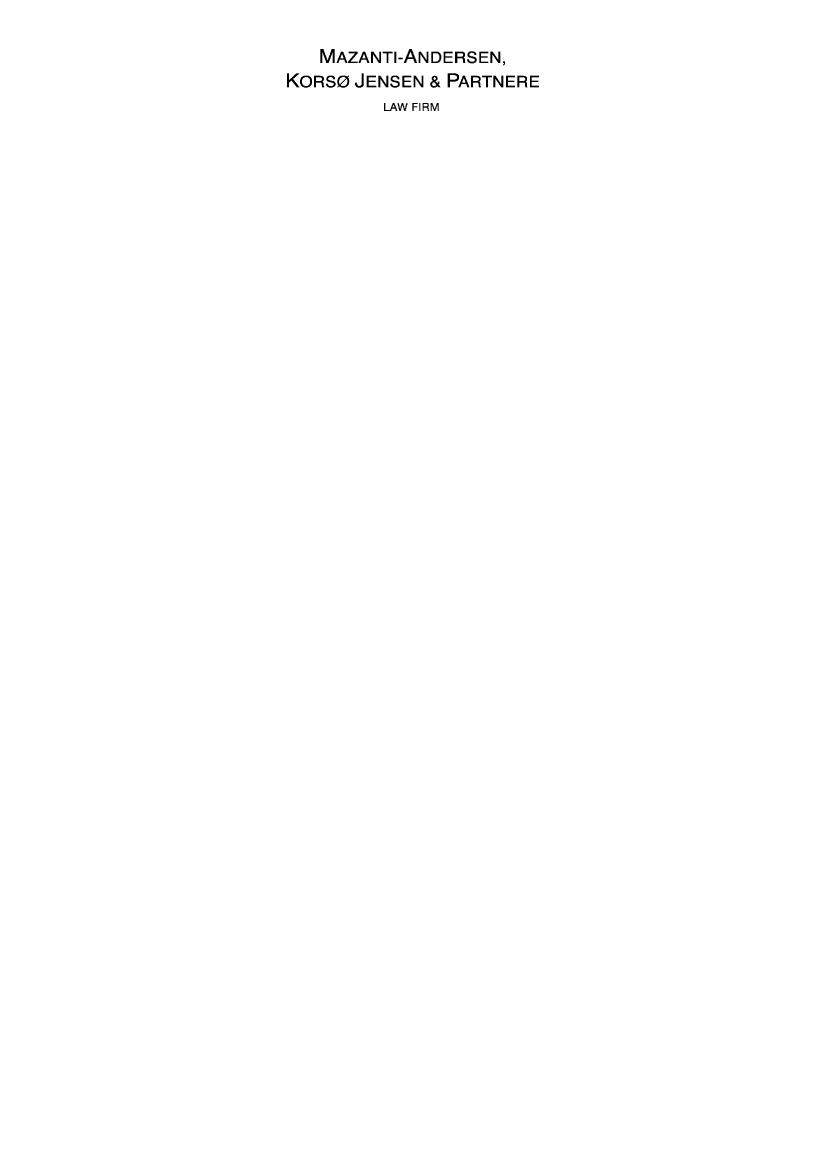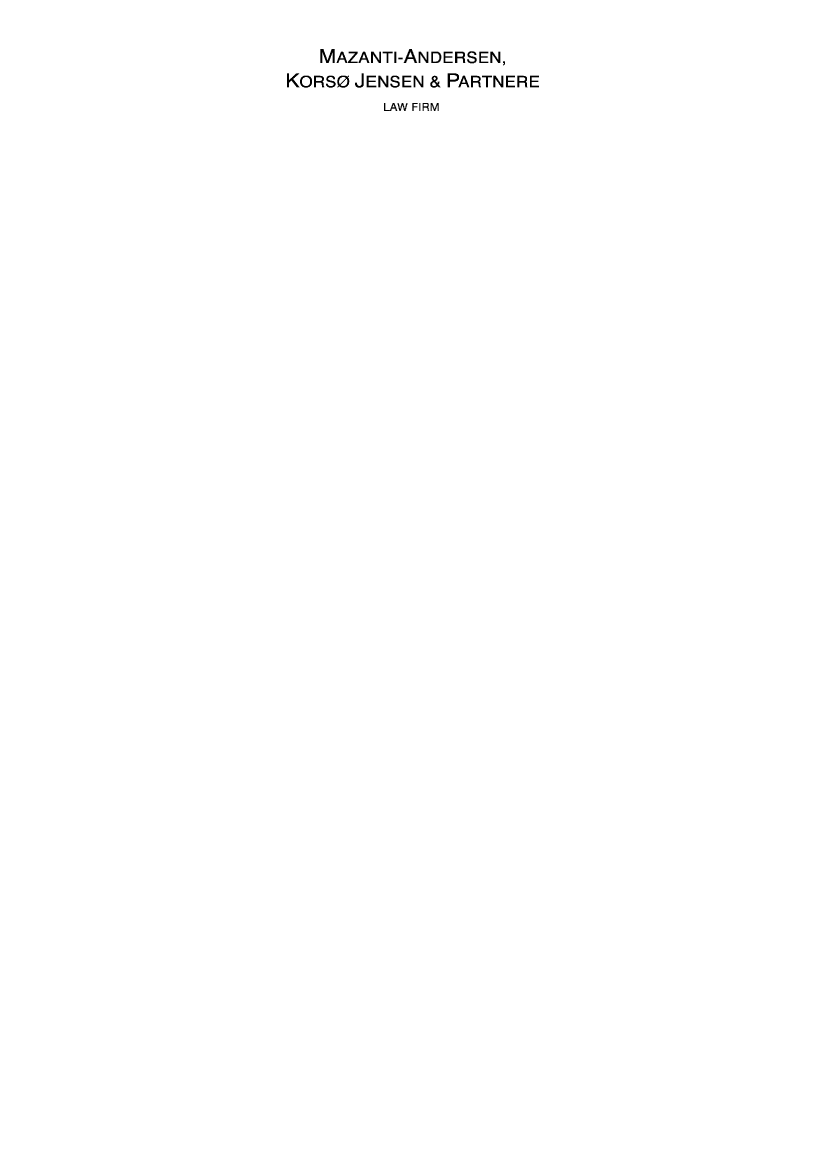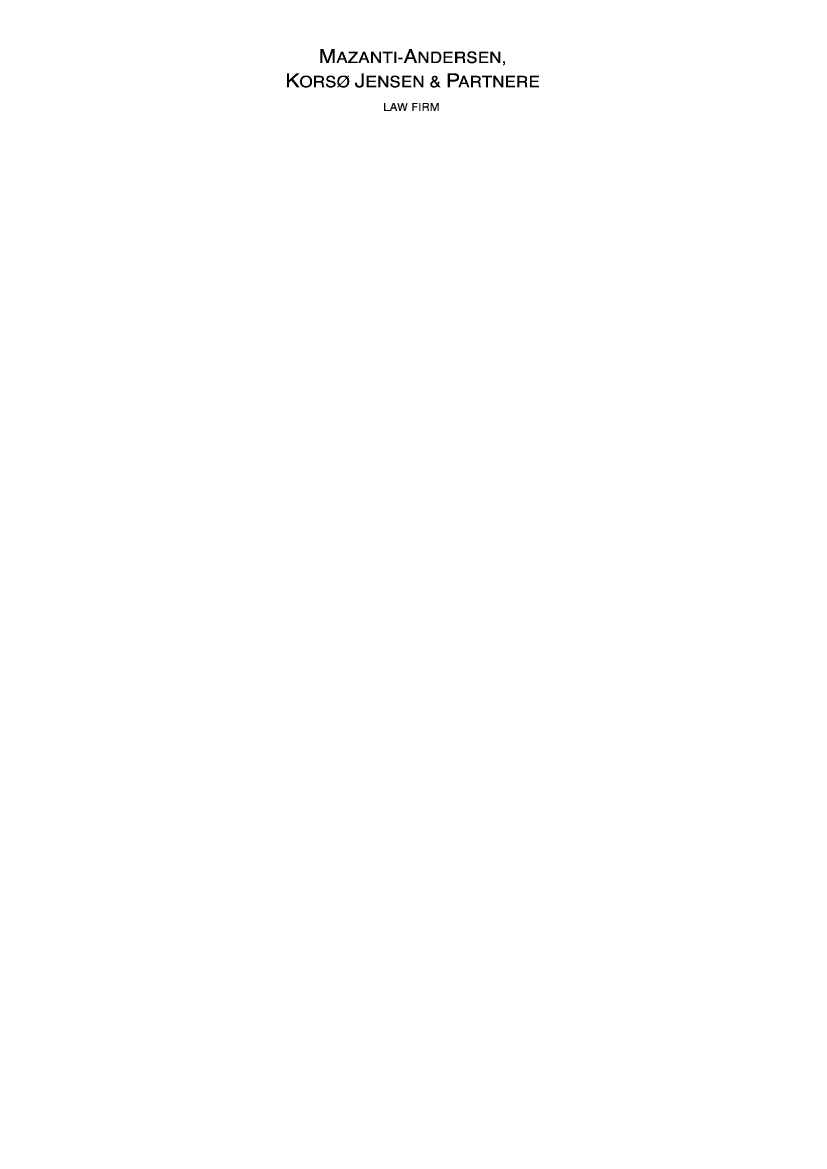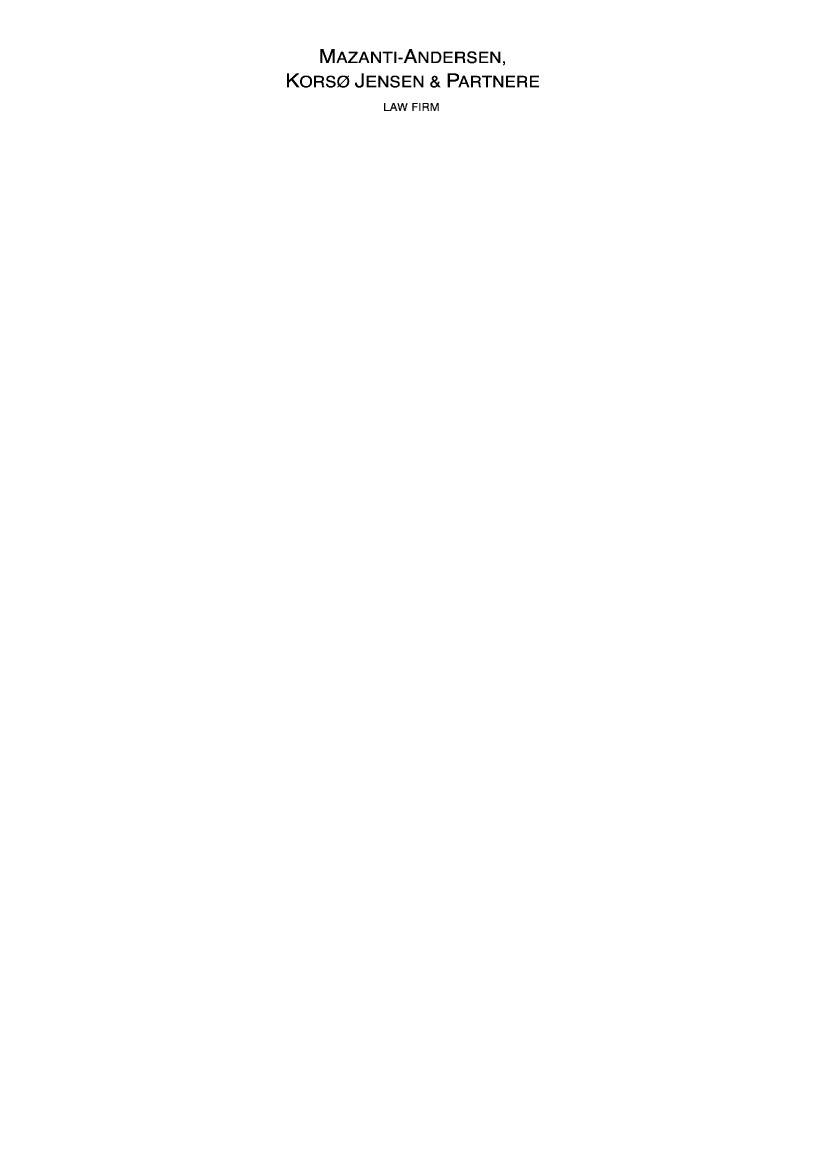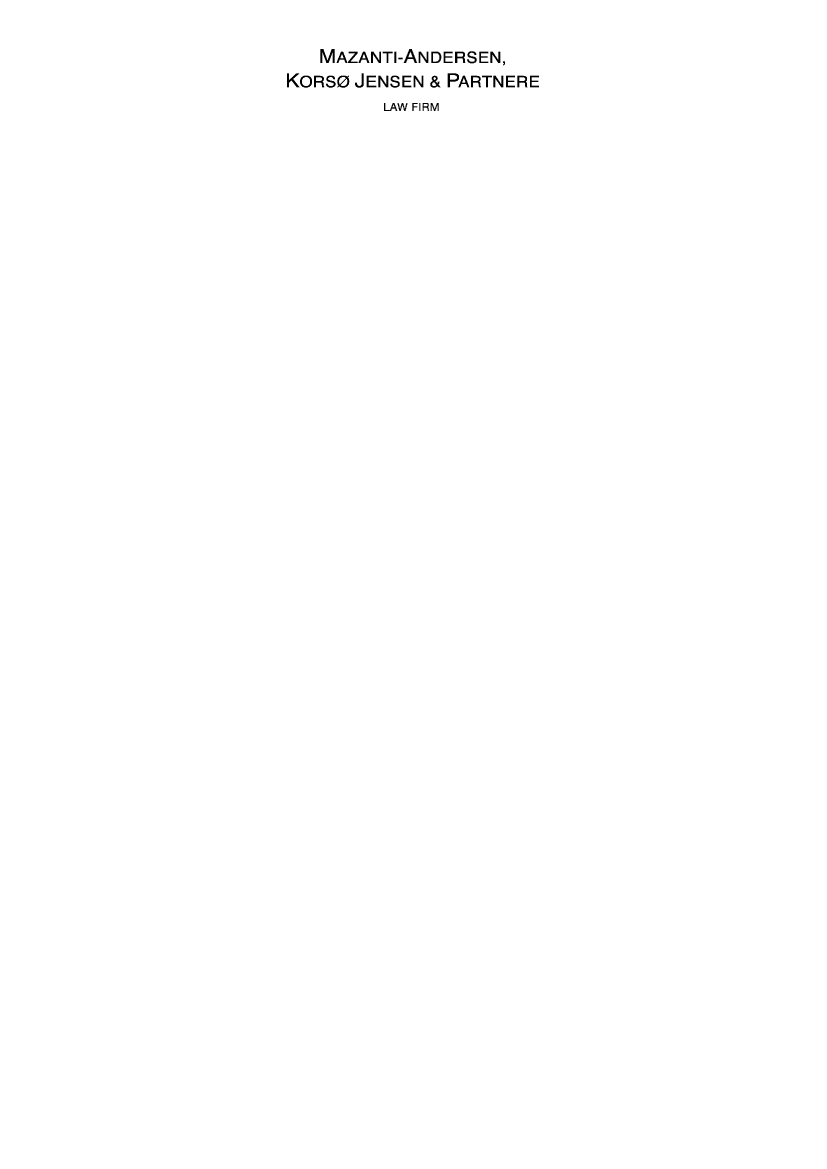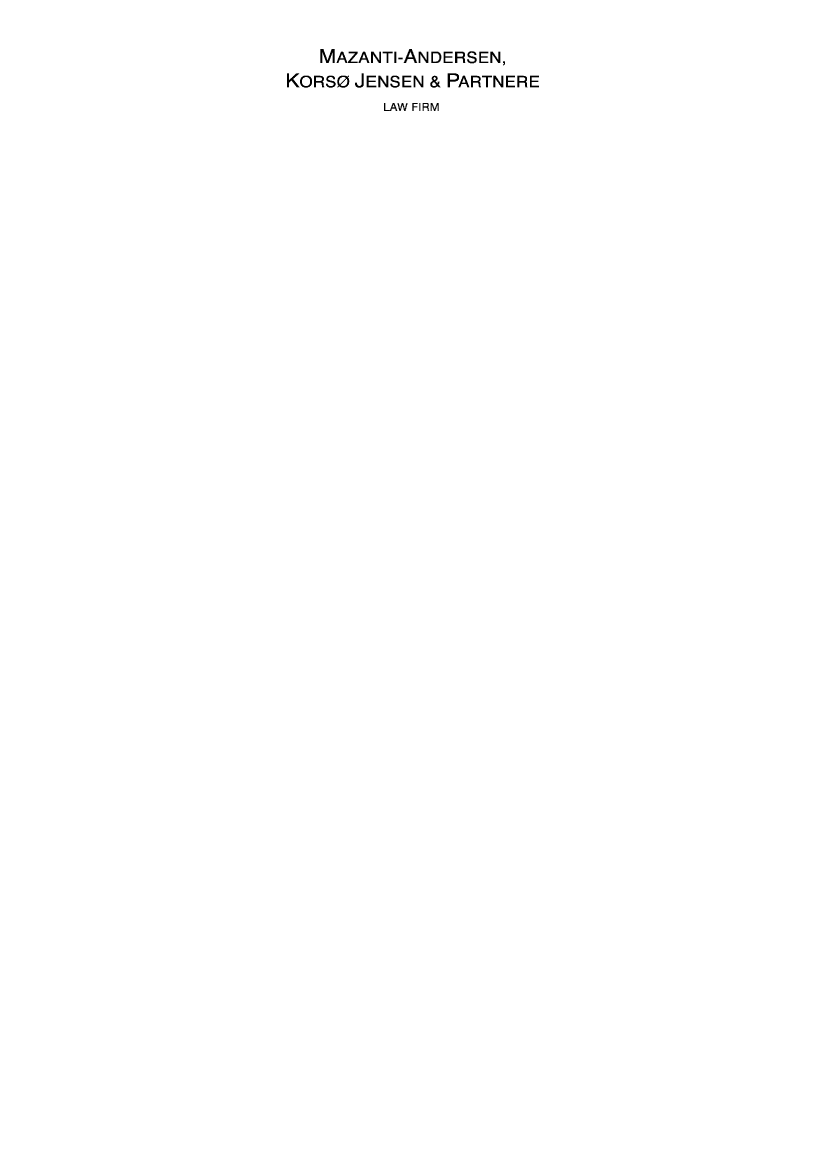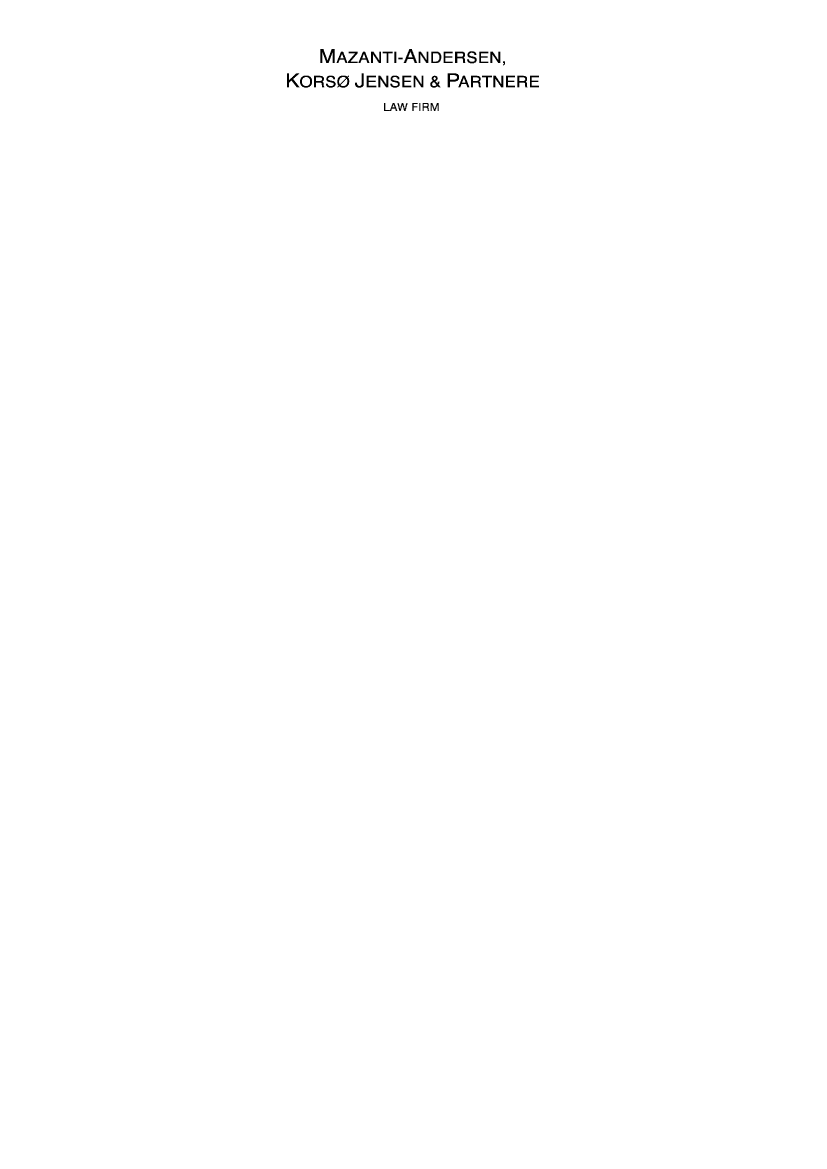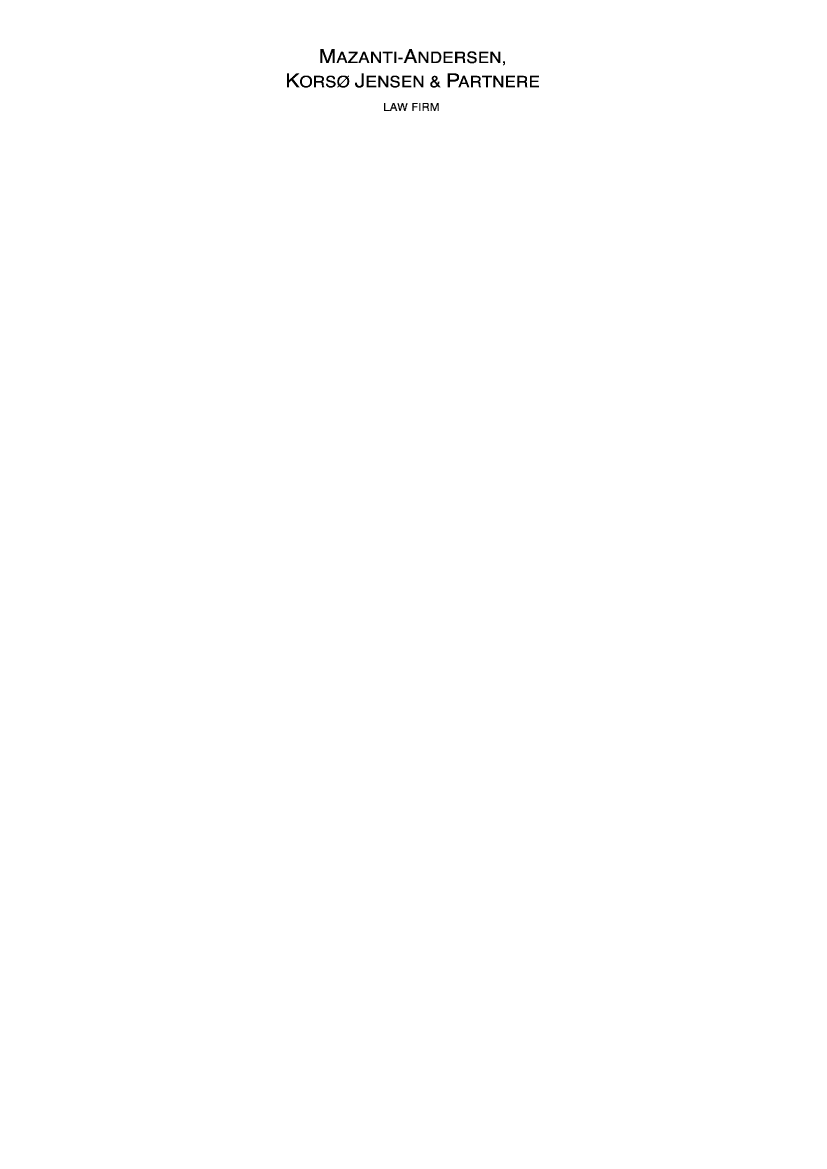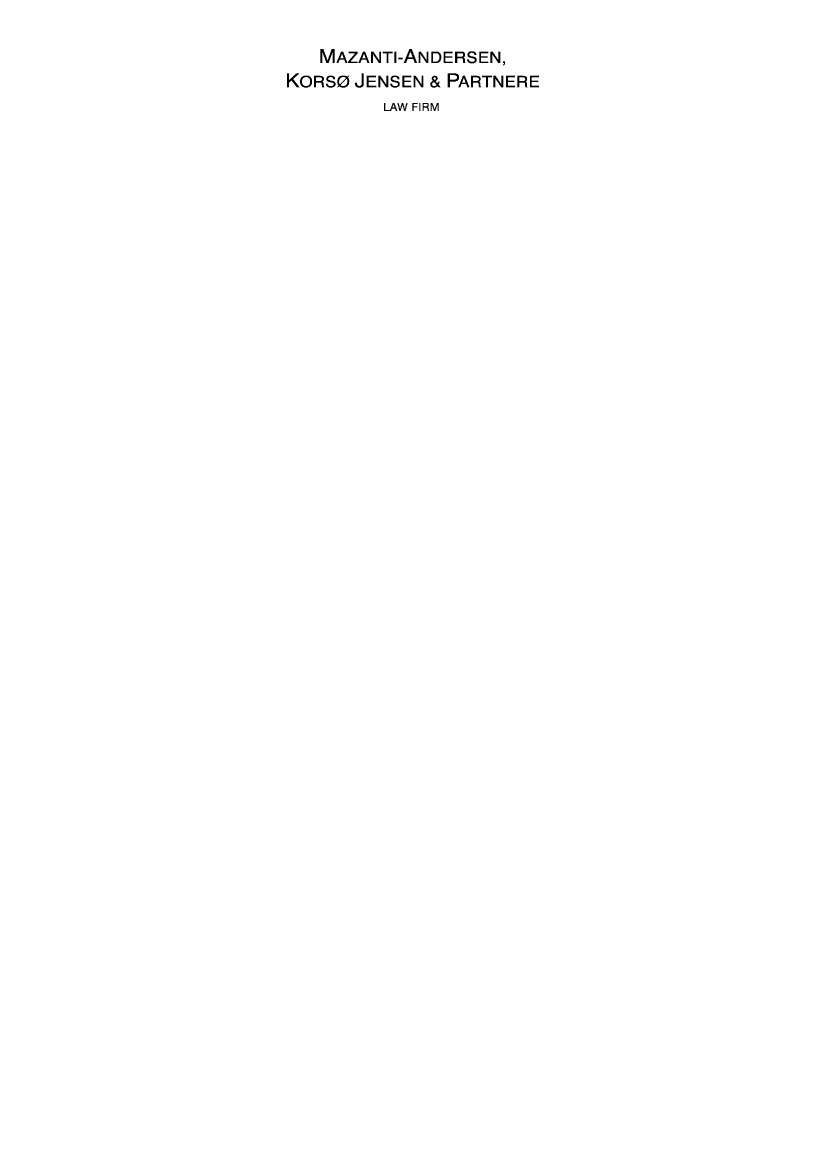Udvalget for Fødevarer, Landbrug og Fiskeri 2008-09
L 80 Bilag 26
Offentligt
MEMORANDUMregarding ban on fox keeping
This memorandum contains an analysis on whether the bill regarding ban on fox keepingcan be adopted in accordance with Community law.1.1.1
The BillThe Ban
On 30 September 2008, the Danish Ministry of Justice submitted its bill regarding“The Act on Ban on Fox keeping” for a public hearing procedure. The bill wasaccompanied by official explanatory notes to the bill prepared by the Danish Min-istry of Justice.The bill contains a general ban on fox keeping (the “Ban”). The bill, however,does not ban trading of live foxes or fox skins.Persons, who prior to the effective date of the proposed act (if enacted) havestarted their own business of fox keeping, may, however, continue such businessuntil 31 December 2016. Persons, who prior to the effective date of the proposedact (if enacted) have started their own business of fox keeping and who, at suchpoint in time, had fox keeping as their main profession, may, however, continuesuch business until 31 December 2023, subject to the consent of the Danish Min-ister of Justice. According to the official explanatory notes to the bill, this transi-tional rule has been proposed in order to avoid payment of expropriation compen-sation to the fox breeders.1.2The objective of the bill
In the official explanatory notes to the bill, it is stated that
2
”The bill, which is based on animal ethical considerations, seeks to introducea ban on fox keeping in Denmark. The background of the bill is that it hasnot been possible on a general basis to prescribe housing, which will ensurethat foxes held in captivity are afforded reasonable conditions.”
Further, it is stated under ”The background for the Ban on Fox Keeping” that”During the Autumn of 2007 it became questioned whether the rules con-tained in the executive order on fur animals functioned as intended. One foxbreeder, who during the Autumn of 2007 had furnished a number of cages inaccordance with the executive order’s requirements, indicated among otherthings that the rules did not lead to better animal welfare. (…) The DanishAssociation of Fox Breeders and the fox breeder in question believe that thenew rules on fox breeding imply a significant deterioration of animal welfareof foxes.””The discussions have led the Danish Ministry of Justice to the conclusionthat it is not possible to prescribe a production method, which secures thefarm fox reasonable conditions and on this background it is proposed that aBan on fox keeping is adopted.”
The Danish Ministry of Justice states that the purpose of the bill is to serve “ani-mal ethical considerations”, while they at the same state that the background forthe bill is to serve “animal welfare consideration”.However, the official explanatory notes to the bill do not account in any greaterdetail for the animal ethical considerations which according to the preparatorywork are the purpose of the bill. On the contrary, only animal welfare considera-tions are accounted for in detail, such as with respect to design of fox cages; andthe animal welfare considerations thus seem to be the genuine objective of thebill.2.2.12.1.1
Is the Ban compatible with Community law?EU regulation of relevance to the evaluationArticles 28 and 29 of the EC Treaty
3
Article 28 of the EC Treaty (“the Treaty”) contains a prohibition on quantitativerestrictions or measures having equivalent effect on imports within the Commu-nity. Article 29 of the Treaty contains an equivalent prohibition against quantita-tive restrictions or measures having equivalent effect on exports.Such quantitative restrictions on imports and exports are only permitted, if theyfall within the scope of one or more of the legitimate grounds set forth in Article30 of the Treaty, such as considerations for the public order or protection of thelife and health of human beings and animals.2.1.2The Council’s Regulation No 827/68 on the common organization of the market in certainproducts
Live fur animals fall within the scope of Council Regulation no. 827/68 on thecommon organisation of the market in certain products (the “Market Organisa-tion”). Fur skins, on the contrary, do not fall within the scope of the Market Or-ganisation.Article 4 provides that all quantitative restrictions or measures having equivalenteffect are prohibited in trade within the Community with regard to products fal-ling within the scope of the Market Organisation.2.1.3The European Parliament’s and the Council’s Directive 98/58/EC of 20 July 1998 concern-ing the protection of animals kept for farming purposes (the “Directive”)
The Directive governs the ”protection of animals kept for farming purposes”.The Directive defines ”animal” as animals, which are bred or kept for the produc-tion of food, wool, skin or fur or for other farming purposes, cf. Article 2 of theDirective.According to the eighth recital of the Directive, the purpose of the Directive is toestablish minimum standards for the protection of animals kept for faming pur-poses in order to ensure rational development of production and to facilitate theorganization of the market in animals and to secure an equal implementation andapplication of the principles, which are set forth by the European Convention onprotection on animals kept for faming purposes (the “Convention”) and the rec-ommendations adopted pursuant to the Convention. These principles relate to
4
among other things housing, feeding, watering and tending. The Convention hasbeen approved by the European Community by Decision 78/923/EC.The latest recommendation adopted pursuant to the Convention regarding furanimals are from 1999 (“the Recommendation”). This Recommendation containsin Appendix C detailed provisions regarding foxes.Article 3 of the Directive states that the Member States shall make provisions toensure that the owners or keepers take all reasonable steps to ensure the welfareof animals under their care and to ensure that their animals are not caused anyunnecessary pain, suffering or injury.Further, Article 4 of the Directive provides that the Member States shall ensurethat the conditions under which animals are bred or kept comply with the provi-sions set out in the annex to the Directive, including staff, supervision, freedom tomove and buildings used for housing of animals.Finally, Article 10 (2) of the Directive states that the Member States may adoptprovisions for the protection of animals kept for farming purposes stricter thanthose set forth in the Directive, provided, however, that such (stricter) provisionscomply with the general provisions of the Treaty.2.2The compatibility between the Ban and prevailing EU regulation
Firstly, the compatibility of the Ban and Community law should be evaluated onthe basis of the Directive (cf. item 3 below) and secondly, evaluated on the basisof the Market Organisation (cf. item 4 below).In this connection, it is noted that the Danish Ministry of Justice – when analys-ing the issue and finding the Ban to be compatible with Community law – solelyrefers to the Market Organisation and that the Directive is neither mentioned inthe bill nor in the official explanatory notes to the bill.Further, it is noted that the Danish Ministry of Justice in its memorandum to thebill states that it is not possible to prescribe a production method, which securesthat the farm fox has reasonable conditions. It is not entirely clear whether theDanish Ministry of Justice is of the opinion that this is an animal ethical and notan animal welfare problem. However, “rooms and building to animals” are in-cluded in Annex 1 to the Directive and minimum dimensions on the fox cages are
5
included in Appendix C to the Recommendation. Since both the Directive, theConvention and the Recommendation concern animal welfare and not animal eth-ics and since the official explanatory notes to the bill takes into account the sameconsiderations as set forth in the Directive, the Convention and the Recommenda-tion, the official explanatory notes to the bill (and the bill) also concerns animalwelfare and not animal ethics.Therefore, the evaluation of the compatibility between the Ban and Communitylaw is to be made on the basis of the rules on animal welfare.3.3.1
The DirectiveArticle 10 (2)
Article 10 (2) of the Directive provides the possibility for the Member States toadopt stricter provisions for the protection of animals in their territory comparedto those laid down in the Directive, provided, however, that these (stricter) provi-sions are in accordance with the general rules of the Treaty.By proposing the Ban, Denmark now intends to implement stricter provisionscompared to those laid down in the Directive.According to the wording of Article 10 (2) these stricter provisions shall relate tothe Member State’s own territory and the measures are only allowed to the extentthat they are compatible with the general regulations of the Treaty.It should be evaluated whether the Ban constitutes a trade barrier pursuant to Ar-ticle 28 and/or 29 of the Treaty (item 3.2 and 3.3). If this is the case, it should beevaluated if the trade barrier can be justified by one of the legitimate grounds setforth in Article 30 of the Treaty (item 3.4).3.2Evaluation of import barriers (Article 28 of the Treaty)
In case 8/74, Dassonville, paragraph 5, the European Court of Justice (the“Court”) ruled that any measure adopted by a Member State constitutes a tradebarrier according to Article 28 of the Treaty, if the measure is capable of hinder-ing, directly or indirectly, actually or potentially, the intra-community trade.
6
It is not a requirement that the trade barrier shall appreciably affect the intra-community trade, cf. e.g. 177/82 and 178/82, van de Haar. It is sufficient for ap-plying Article 28 of the Treaty that it is demonstrated that the measure directly orindirectly, actually or potentially has a negative effect on the intra-communitytrade, cf. 53/76, Bouhelier.Live foxes are a product in the sense of Article 28 of the Treaty. This is empha-sized by the fact that live animals are comprised by the Market Organisation.Imports of live foxes from other Member States to Denmark will be prevented, ifthe Ban is adopted. In this connection, it is noted that imports of live foxes fromNorway and Finland to Denmark exist today. Therefore, the Ban constitutes aquantitative trade barrier for imports of live foxes according to Article 28 of theTreaty. In addition, it is noted that the Ban also indirectly hinders the intra-community trade of fox skins. The evaluation is unaffected by the fact that thebill provides for a transitional period.3.3Evaluation of export barriers (Article 29 of the Treaty)
Article 29 of the Treaty has a wording equivalent to that of article 28 of theTreaty, but with respect to export restrictions.In case 15/79, Groenveld, the Court ruled that Article 29 of the Treaty only pro-hibits national measures, which have as its purpose or impact to hinder the exporttrade between Member States, and thus discriminates between the national tradeand the intra-community trade, whereby the national production obtains an ad-vantage to the detriment of the intra-community trade.The above case concerned a ban on manufacture of meat products based onhorsemeat. This ban applied both to the national market and the export market,whereby no discrimination was made between the national market and the exportmarket. Therefore, the ban was not held to be incompatible with Article 29 of theTreaty.Case C-1/96, Compassion in World Farming (the ”Compassion-case”) concerneda ban on export of live calves from England to other Member States. Since thisban created discrimination between the trade on the national market in the Mem-ber State and the export trade, the ban was held to constitute a quantitative tradebarrier incompatible with Article 29 of the Treaty.
7
The Court has never explained why the scope of Article 28 and 29 of the Treaty isnot identical, even though the provisions have equivalent wording, and this dif-ference between the interpretation of the two provisions has by commentatorsbeen criticized on numerous occasions, cf. e.g. Wulf-Henning and others: ”Exportof Goods and Services within the single market”, page 33.The ban on fox keeping will hinder the export of live foxes and related products,such as fox skins, from Denmark to other Member States.The Ban applies generally to the fox keeping in Denmark, and no direct discrimi-nation between the trade on the Danish market and the export market is thereforegenerated. However, the Ban will have a substantial impact on the intra-community trade of live foxes and related products, such as fox skins. This willcreate a substantial indirect difference between trade on the Danish domesticmarket and the export market. Thus, the Ban is likely to constitute an indirectquantitative restriction incompatible with Article 29 of the Treaty3.4Is the Ban justified on legitimate grounds pursuant to Article 30 of the Treaty
If the Ban is considered to violate Article 28 and/or 29 of the Treaty, the conse-quence is that the Ban will only be allowed, if the Ban is justified on one or moreof the legitimate grounds set forth in Article 30 of the Treaty, such as considera-tions regarding the public order or protection of the life and health of human be-ings and animals. This will be examined below.3.4.1Article 30 of the Treaty
Article 30 of the Treaty states that quantitative trade barriers are allowed, if theyare justified on the grounds of public order, public morals or animal’s or humanbeing’s life and health.In several cases, including C-421/04, Concord paragraph 20 and C-209/92, Spitz,paragraph 59, the Court has ruled that if an area has been fully harmonized, it isno longer admissible for a Member State to take recourse to Article 30. In suchcase, the national measure shall be evaluated according to the provisions of theharmonisation directive and not Article 30 of the Treaty.
8
The following considers whether the Directive implies a full harmonisation of theareas of animal ethics and/or animal welfare.3.4.2Evaluation of whether the Directive entails harmonisation
According to both its purpose and its content, the Directive concerns the ”protec-tion of animals” in an animal welfare sense. Animal ethical considerations areneither mentioned in the Directive.Hence, it should be examined whether the Directive determines such harmonisa-tion measures regarding animal welfare that the Member States are preventedfrom adopting legislation on this area.Settled case law provides that this examination shall be made on the basis of i)the context of which the Directive is part of, ii) the Directive’s purpose and iii)the wording of the Directive, cf. case C-127/94, Hönig, paragraph 9 and Compas-sion, paragraph 49.Regarding the Directive´s context, it appears from the two first recitals of the Di-rective that the Directive’s provisions on minimum requirements regarding pro-tection of animals kept for faming purposes are based on the Convention and theRecommendation.As stated in the recitals to the Directive, the purpose of the Directive is to deter-mine the minimum requirements regarding protection of animals kept for farmingpurposes in order to secure a rational development of the production and facilitatethe organization of the animal market and further to secure a uniform applicationof the principles imposed by the Convention and the Recommendations adoptedpursuant hereto.With regard to the wording of the Directive, Article 3 states that the MemberStates shall make provisions to ensure that the owners or keepers take all reason-able steps to ensure the welfare of animals under their care and to ensure thatthose animals are not caused any unnecessary pain, suffering or injury. Further,article 4 of the Directive imposes on the Member States to ensure that the condi-tions under which animals are bred or kept comply with the provisions set out inthe Annex to the Directive, including staff, supervision, freedom to move androoms and buildings to house animals.
9
In Compassion, the Court examined, if export of calves to other Member States,which did not guarantee the same high standard for animals, as provided by Eng-lish law, could be prohibited. The area was regulated partly by the Convention,partly by the market organisation regarding beef and veal and finally Directive91/629/EC regarding determination of the minimum requirements in connectionwith protection of calves.Article 11 (2) of directive 91/929/EC contained a clause identical to Article 10 (2)of the Directive.When examining whether the directive 91/929/EC contained the harmonizationmeasures necessary for the welfare of calves, the Court assessed the context ofthe directive, the purpose of the directive and the wording of the directive.The Court ruled that the directive 91/929/EC was part of the policy adopted bythe European Parliament concerning animals’ welfare and the European Union’sapproval from 1978 of the Convention.Further, the Court ruled that the purpose of the directive was to secure the com-mon marketing organisation for calves and related product would work satisfacto-rily and secure the minimum requirements to protect breeding calves and fattedcalves in order to guarantee a rational development of the production.Finally, the Court ruled that the directive did contain requirements with regard tominimum space for calves and that the directive obligated each Member State tomake sure that the breeding of calves took place in accordance with the require-ments laid down in an appendix to the directive, including minimum require-ments to space and feed.On this basis, the Court concluded that it appears from the wording and the con-text of the directive as well as from the objectives which it pursues, that the direc-tive determines common thorough minimum requirements to protection of calveswhich are kept in buildings for breeding and fattening. Therefore, a ban on ex-ports of live calves would undermine the harmonisation implemented. Accord-ingly, England could not restrict the export of calves to other Member States withreference to the protection of calves’ welfare or other considerations set forth inArticle 30 of the Treaty.
10
The Directive has significant similarities with the directive examined in Compas-sion and this ruling of Compassion can - to a large extent – be applied to the legalanalysis of the Directive.The Court´s rulings in Compassion establishes that a minimum harmonisation di-rective may constitute a full harmonisation of an area, if the directive, in accor-dance with its purpose, contents and the context of which it is part, aims at deter-mining thorough minimum requirements for the specific area.By referring to the Convention and the Recommendation, the Directive provides adetailed regulation regarding fox keeping. Article 4 of the Directive states that theMember States shall ensure that the conditions under which animals are bred orkept comply with the provisions set out in Appendix 1 to the Directive with spe-cific requirements to staff, supervision, freedom to move as well as rooms andbuildings used for housing of animals. Further, the Recommendation sets forthdetailed rules on the size of fox cages, equipment, enclosure, hygiene, feed andtemperature.When taking into consideration the similarities between the Directive and direc-tive 91/629/EC examined in Compassion, as well as the detailed regulation,which follows from the Directive, the Convention and the Recommendation, it isour opinion that the Directive lays down the common thorough minimum re-quirements for welfare of foxes, and consequently that the Directive provides afull harmonization within this area.3.4.3Other Article 30 considerations
As stated above under item 3.4.1 quantitative trade barriers are permitted, if theyare justified on the grounds set forth in Article 30 of the Treaty.Item 3.4.2 above concludes that the Ban is not justified on the grounds of animalwelfare, because the Directive entails full harmonization of this area.In several rulings the Court has stated that if an area has been fully harmonised,the Member States can no longer take recourse to article 30, cf. C-421/04, Con-corde, premise 20, and C-309/02, Spitz, premise 59.If an area has been fully harmonised, the Member States are compelled to applythe exemptions contained in the harmonization act, and if the act does not contain
11
exemptions or special rules, the Member States are prevented from introducingnational measures, which hinder intra-community trade, cf. 251/78, Denkavit Fut-termittel, premise 14. This is supported by the Compassion-case, paragraph 67and 68, in which the Court rejected that other legitimate grounds set forth in Arti-cle 30 of the Treaty can justify measures which are incompatible with a harmoni-sation act introduced by one of the Community Institutions.It follows that the Ban cannot be justified on the grounds set forth in Article 30 ofthe Treaty, since the Directive constitutes a full harmonization of animal welfare.3.4.4National measures justified on the grounds of animal ethics
It can be derived from the Court´s case law that even though some aspects of aspecific product have been harmonized, the Member States are still entitled toadopt legislation regarding other aspects of the same product, which have notbeen subject to harmonization.Consequently, the Member States are not prevented from adopting measures onthe grounds of animal ethics, even though the field of animal welfare has beenharmonised.However, it should be emphasized that since requirements for the protection offoxes have been adopted on Community level, the Community has at the sametime determined that fox keeping from an animal ethics´ point of view is admissi-ble. Accordingly, the Member States are not entitled to justify a ban on thegrounds of animal ethical considerations.This is emphasized by the fact that breeding of fur animals is regulated in greatdetail by the Recommendation. Denmark has participated in the preparation andadoption of the Recommendation, and the Community, as contracting party, mustgive effect to the principles laid down in the Convention. Consequently, the Banis incompatible with this Community regulation. Further, the Recommendationencompasses such enhanced and detailed rules regarding fox keeping that thewelfare of foxes has been secured on Community level. Hence, the Communityhas considered it possible to prescribe a production method, which secures rea-sonable conditions for foxes. This also means that animal ethics - being moralconsiderations - as ground for a national ban are not admissible.
12
4.
The Market OrganisationLive fur animals fall within the scope of the Market Organisation. Fur skins, onthe contrary, do not fall within the scope of the Market Organisation.The consequence of live fur animals falling within the scope of the Market Or-ganisation, is that all quantitative restrictions and measures having equivalent ef-fect (both with regard to imports and exports) are prohibited within the Commu-nity.Since the Ban hinders trade in live foxes, the Ban constitutes a quantitative re-striction, which is prohibited according to the Market Organisation.It is settled case law that the establishment of a common organisation of the mar-kets does not prevent the Member States from applying national rules intended toattain an objective relating to the general public interest other than those coveredby the common organization; even if those rules are likely to have an effect onthe functioning of the common market in the sector concerned, cf. C-462/01,Hammarsten, paragraph 29.With reference to Hammarsten, the Danish Ministry of Justice argues in the offi-cial explanatory notes to the bill that the Member States are free to introduce aban on certain products governed by the Market Organisation, including live ani-mals, provided that the ban pursues public purposes. The Danish Ministry of Jus-tice assumes that a ban on breeding of foxes is justified on the grounds of generalpublic considerations, which are not governed by the Market Organisation, sinceneither the preamble nor the wording of the Market Organisation state that animalethical considerations are pursued.The Danish Ministry of Justice’s interpretation of Hammarsten and the way thisinterpretation is applied in support of the legality of the Ban, is not correct.Firstly, the arguments of the Danish Ministry of Justice are only applicable to theextent that the Community has not already harmonised the area of “the specificpublic consideration”, which is the background of the bill.As stated under item 1.2 above, the genuine motivation for the Ban is animal wel-fare considerations rather than animal ethical considerations. Therefore, the Banshould be examined on the basis of the rules which apply to animal welfare. As
13
already stated, the Directive constitutes a harmonisation of the area for protectionof animals, which prevents the Member States from adopting legislation in thisarea, unless in accordance with the Directive. Moreover, as stated above, the Bancannot be adopted with reference to Article 10 (2) of the Directive.Even if the bill – genuinely – was motivated by animal ethical considerations, thiswould not constitute a public consideration (cf. above), as the Community by theDirective, the Convention and the Recommendation has already in great detailadopted rules on fox keeping and thereby determined that it is justifiable to keepfoxes seen from an animal ethical point of view.Secondly, in Hammarsten the Court ruled that the Swedish Government could notjustify a ban on cultivating of industrial hemp on the ground of human health,since a regulation on the introduction of restrictions on import of hemp alreadytook these health risks into consideration. Thus, Hammarsten very clearly ex-presses that the Member States cannot justify national measures on public consid-eration, which have already been regulated by the Community.In Compassion, the Court ruled (paragraph 53) in relation to the correspondingmarket organisation for calves and related products that the purpose of the direc-tive for calves and related products was to ensure the smooth functioning of themarket organisation. If this argument is applied to fur animals, it means that theobjective of the Directive is to secure the Market Organisation for live fur ani-mals. The consequence hereof is that the desire to secure an efficient and smoothfunctioning of the Market Organisation hinders the Member States in adoptingbans on production of live fur animals.In consideration of the above, it is our opinion that the Ban is incompatible withthe Market Organisation.5.5.1
Fundamental Community principles: Proportionality and equalityProportionality
Even if a quantitative restriction is justified on legitimate grounds comprised byarticle 30 of the Treaty, the quantitative restriction constitutes a violation ofCommunity law, if the restriction infringes the principle of proportionality.
14
When determining whether a quantitative restriction infringes the principle ofproportionality, the Court evaluates, if the national measure is more extensivethan necessary. This involves an evaluation of the following:1. If the measure is appropriate for meeting the objectives pursued by the legislation in ques-tion;2. if the pursued objective can be obtained with less restrictive measures, i.e. measures whichhave a less harmful impact on the trade within the Community; and3. if the national measure is proportionate to the objective pursued by the legislation in ques-tion.
The examination of whether the principle of proportionality has been compliedwith, is dependent on the purpose, contents and context of the specific measure.The burden of proof lies with the Member States and according to settled caselaw, this burden of proof is difficult to satisfy.5.1.1Appropriate for meeting the objectives pursued
As regards the purpose and objective of the measure, reference is made to item1.2 above. It can hardly be disputed that the Ban is appropriate for meeting theobjectives pursued.5.1.2If the objective can be obtained with less restrictive measures?
The measure contains a general Ban on fox breeding. A ban is - per se - the mostextensive kind of restriction. The question is, if the objective and considerations,which the bill pursues, cf. item 1.2 above, can be reached by adopting less exten-sive measures, e.g. by adopting new provisions regarding housing etc.According to the official explanatory notes to the bill, the Danish Ministry of Jus-tice has – based on a meeting with a fox breeder in December 2007 - concludedthat it is not possible to provide a production method, which secures the farm foxreasonable conditions. This is the reason, why the Danish Ministry of Justice hasdecided to adopt the Ban rather than less extensive measures.
15
Together with the Convention and the Recommendation, the Directive containsdetailed regulation regarding the fox keeping, including specific regulation onhousing etc.As set forth above the Danish Ministry of Justice has the burden of proof that aBan – seen from a scientific perspective – is the only possible way to secure thewelfare of farm foxes. Based on the available expert opinions, there is no scien-tific reason to assume so. On the contrary, the Danish Council on Animal Ethics(Det dyreetiske råd) has, in its opinion of January 2003 stated that there are areas,where the fur production is in a better position compared to other domestic ani-mals, cf. below. Therefore it is our opinion that the purpose of the bill can be ob-tained by adopting less extensive measures than the Ban.5.1.3Reasonable in relation to the aimed object
The same applies as referred to above under item 5.1.2.5.1.4Evaluation of proportionality
On the basis of the available expert opinions and scientific studies, it can be de-rived that the purpose of the bill can be obtained by adopting less extensivemeasures than a Ban. Therefore, the bill infringes the fundamental Communityprinciple of proportionality.5.2Equality
A number of animals exists, which – similar to foxes – are kept in cages or whichare otherwise confined.If fox keeping is prohibited – as opposed to other species of animals, which arekept in cages or otherwise confined - it is required that professional analyses ofanimal ethics and welfare demonstrate that it is worse to keep foxes in cages thanother species of animals.The Danish Council on Animal Ethics has in the opinion referred to above madethe following statement regarding foxes:”Seen from a welfare point of view, some scientists have concluded that thelevel of welfare in fur production is acceptable, and that the fur animals are
16
not necessarily in a worse position than many other animals in our produc-tion of domestic animals (…). Seen from a welfare point of view, the Coun-cil finds that there are strengths and weaknesses in all methods of productionof domestic animals, and acknowledges that there are areas, where the furproductions is in a better position compared to other domestic animals, e.g.that the animals are intact (no castration), that the animals are not pressed interms of reproductions and that the killing of the animals takes place at thefarm, whereby the animals avoid transportation to abattoirs, contrary to otherspecies of domestic animals.”
The above statement allows the conclusion that no scientific justification for aBan on the fox keeping exists, when keeping of other species of animals in cagesor otherwise confined, remains allowed.6.
Comments from the Danish Ministry of Justice to the European Commissionfrom respectively 1999 an 2001 in connection with English and Dutch billsregarding Ban on keeping of fur animalsIn 1999 England notified a bill to the European Commission regarding a Ban onkeeping of fur animals in England and Wales and in 2001 Holland notified a Banon keeping of fur animals.The Danish Ministry of Justice states in two almost identical comments that theBan on fur animals will have an impact on intra-community trade of live fur ani-mals between respectively England and Holland and the other Member States andthat it cannot be ruled out that a Ban on fur animals indirectly “has an impact onintra-community trade of fur skins”. Further, the Danish Ministry of Justice statesthat the Directive was adopted in order to secure the implementation of the prin-ciples, which are laid down in the Convention and secure that the Convention andthe Recommendation are applied in a uniform manner.The Danish Ministry of Justice questions, if the Ban on fur farming is in accor-dance with the prevailing provisions, including the Recommendation. The DanishMinistry of Justice emphasizes that respectively England and Holland partici-pated in the preparation and adoption of the Recommendation, and that theCommunity according to the Directive shall secure a uniform application of theConvention and recommendation.
17
Further, it is stated that the adoption of such detailed provisions, as the Recom-mendation, implies that the welfare of fur animals have been secured in such amanner that “ethical” considerations cannot be invoked as a valid reason for theBan.Finally, the Danish Ministry of Justice refers to the fact that live fur animals aregoverned by the Market Organisation, and that the Market Organisation prohibitsany quantitative restrictions and measures having equivalent effect on this area.If the comments from the Danish Ministry of Justice of respectively 1999 and2001 are compared to the official explanatory notes to the bill, it can be con-cluded that there is a remarkable difference in the line of reasoning: Approxi-mately 10 years after, the Danish Ministry of Justice has argued that the Englishand Dutch bans were incompatible with Community law, they now – without anyreason or legal arguments - reach the exact opposite result, namely that the Ban iscompatible with Community law.7.
ConclusionAs regards trade in live foxes, it is our conclusion that the Ban constitutes a quan-titative restriction, which is incompatible with article 28 and 29 of the Treaty andthe Market Organisation.As regards trade with fox skins, it is our conclusion that the Ban is likely to con-stitute an indirect quantitative restriction incompatible with article 29 of theTreaty.The Ban cannot be justified on the grounds of animal ethics or other legitimategrounds comprised by article 30 of the Treaty. Further, the Ban is incompatiblewith the fundamental principles of proportionality and equality.Based hereof, it is our overall conclusion that the Ban is incompatible withCommunity law.
Copenhagen, 17 December 2008Lise HøghFrederik B. Hasling
